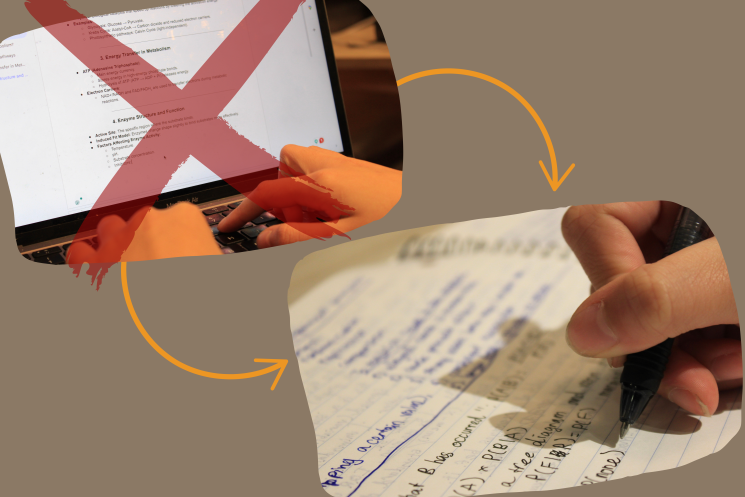
By Kevin Tran
Imagine acing your next exam, not because you typed faster, but because your brain remembered more— sounds like magic, right? The secret lies in something as simple as a pen and paper and jotting down notes from what you’ve learned from class.
Note-taking is one of the most essential skills for studying and learning. It’s a practice nearly everyone relies on to grasp new concepts, stay organized and succeed academically.
However, when it comes to how people take notes, pen-and-paper notes are the superior method of taking notes in comparison to digital notes.
According to research, from Princeton and the University of California, Los Angeles, cited in an article published by the Harvard Graduate School of Education, “in a series of laboratory experiments, researchers … had students watch a lecture, randomly assigning them either laptops or pen and paper for their note-taking. Understanding of the lecture, measured by a standardized test, was substantially worse for those who had used laptops.”
This finding highlights the importance of how information is processed during note-taking. Sure, digital notes may be faster to create, but typing often results in passive transcription where students simply record information word-for-word without truly engaging with or processing the material. In contrast, handwriting notes require students to process and summarize information, hence guaranteeing better understanding and memory retention.
Beyond how information is processed, encouraging a focused and distraction-free learning environment is one of the major advantages of handwriting notes.
“Handwritten vs. Digital Notes: Which is Better for Students?” published by Mem, a platform dedicated to improving productivity and learning through innovative note-taking solutions, highlights the advantages of handwriting notes. The article emphasizes the advantages of handwriting notes, explaining that, “with a notebook and pen, there’s no risk of getting distracted by notifications, emails or the temptation to browse the internet. This focused approach can improve concentration during lectures and study sessions.”
This point emphasizes the unique ability of pen-and-paper note-taking to create a distraction-free environment, allowing students to fully engage with the material being taught. Unlike digital devices, which often tempt users into multitasking, handwriting stimulates a sense of mindfulness and intentionality that enhances learning.
However, digital notes have some advantages. With features like keyword searches, cloud storage and tagging, digital notes are easier to organize, search and retrieve information from compared to handwritten notes.
Handwritten notes lack these features for organization, instead naturally encouraging students to structure their thoughts in a meaningful way, aiding recall not just of the content but also of the spatial and visual layout of their notes. The physical act of writing helps students process and internalize information more effectively, reinforcing memory retention.
Nonetheless, it’s important to acknowledge that not all digital notes are equal. Digital handwritten notes, created using a stylus and tablet, represent a hybrid technique that brings together the cognitive advantages of handwriting with the organizational advantages of digital techniques. These types of notes light up the brain the same way traditional handwriting does, fostering understanding and memory retention by emulating the act of writing, but a digital device opens the door to distractions, a major weakness.
Although digital notes may offer speed and technological conveniences, the benefits of handwriting notes are unparalleled when it comes to fostering deeper understanding, memory retention and focus. By engaging both the mind and body, pen-and-paper note-taking encourages active learning, minimizes distractions and allows for a personalized organization that suits the individual’s learning style.





